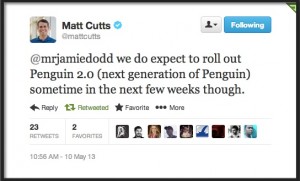
The word on the street is that a new Google Penguin update will be rolling out within the next few weeks – and by all indications, the impact of this particular refresh could be huge.
Matt Cutts – the head of Google’s Web Spam team – recently confirmed the forthcoming Penguin release on Twitter, in response to a question regarding whether or not a new update had already occurred:

As to the update’s scale, a May 13th, 2013 video released by Cutts explained that update “will go deeper and have more of an impact than the first version of the Penguin update.” Considering that the initial Penguin rollout affected a full 3.1% of search queries and took down heavy-hitting websites like Merchant Circle and Similar Sites, that’s no small promise!
Given that the target of past Penguin updates has devaluing spam links, it’s worth considering that the new data that Google has generated through the number of manual resubmission requests they’ve received and submissions to the Disavow Links tool will lead to much more sophisticated spam link detection algorithms.
For this reason, it’s time for a new link building mindset. The writing has been on the wall for some time, but since Google has given an unusual amount of advance notice on this update, it’s up to you to make the changes necessary to your link building methodology to keep your site safe in the future.
Here’s what the ideal link building mindset should look like going forward:
The new link building mindset is NATURAL
In an ideal world, every single link pointing to your website would originate from a natural source – that is, another site simply loves your content so much that it’s compelled to share your pages as a resource.
Of course, we don’t live in this perfect world, and waiting for your site to generate links through natural means could delay the SEO process significantly enough to affect your site’s ability to survive financially.
But that said, there’s a big difference between link building methods like guest posting (which approximate the natural link building process) and others that generate links that have clearly only been created for SEO purposes (as in the case of automated profile link submission systems).
Guess which one you should be focusing on??
As you approach the link building process in the future, your primary thought should be whether or not the backlink you’re creating is one that could also exist naturally. Adding your link to your member profile within the directory of a professional organization you’re already a part of, for example, represents a perfectly natural way to leverage the link building opportunities you’ve always had access to. Posting content to blog networks designed solely for SEO purposes, on the other hand, is not.
The new link building mindset is about TRUST
The concept of “good neighborhoods versus bad neighborhoods” isn’t exactly a new one when it comes to link building. But given the amount of new data Google’s been able to amass recently, it’s an important concept to revisit pre-Penguin 2.0.
Simon Penson, writing for Search Engine Watch, explains how the concept of “link trust” could influence future backlink valuation changes:
“In my view Google uses its Hilltop algorithm, which identifies so-called “expert documents” (websites) across the web, which are seen as shining beacons of trust and delight! The closer your site is to those documents the better the neighborhood. It’s a little like living on the “right” road.”
Not only will building up links from trustworthy sites help to protect your site from negative impacts in future algorithm changes, it could also give your site the wiggle room needed to account for any spam links or other low value connections you’ve made in the past.
Our recommendation here should be pretty obvious: if you haven’t already done so, start to dedicate your link building effort to securing backlinks from high value, trustworthy sites.
The new link building mindset is SOCIAL
Quick question… What’s one of the fastest ways to generate new backlinks if you aren’t able to use spam tools and other automated programs?
The answer is social networking websites.
Social media marketing is an important promotional tool for a number of different reasons, but it’s also a great way to acquire natural links quickly. However, it’s – again – important to note that not all social media activities will provide the same type of value when it comes to backlink creation.
According to Single Grain partner, Neil Patel, writing on his Quick Sprout blog:
“You already know search engines look at social signals to help determine the ranking of a website, but after Penguin 2.0 I think they will focus less on the social count, but more on who is sharing it. If someone with a powerful network of 200 influential (and real) people shares your post, that will carry more weight in Google’s algorithm than a share by someone with a network of 2,000 bots and spam purveyors. If it doesn’t now it soon will.”
When it comes to social link creation, the best things you can do to protect your website from search engine algorithm updates like Penguin 2.0 is to focus on creating good content and disseminating it amongst influential users in your industry with whom you’ve already established relationships. Yes, this will take more time than simply spamming out links to bot accounts, but it’ll be worth it in the long run.
The new link building mindset is FREE
Last up, if you’re paying for links, it’s time to stop.
Google has been pretty clear in the past about its stance on paid links – namely, that if you pay for a link, it shouldn’t be passing link juice on to your site. However, there are plenty of paid link building scenarios that haven’t yet been subjected to this “black and white” type of scrutiny.
As an example, if you pay a Fiverr outsourcer to post your link to 100 different websites, you’ve technically paid for those links – even if your arrangement isn’t as direct as a paid advertorial or other direct link placement.
Whether or not Google is able to devalue these types of grey hat paid links in the forthcoming Penguin 2.0 update doesn’t really matter. Because these links clearly don’t meet the other criteria described above (as they aren’t natural, trustworthy or truly social in nature), it’s still best to rid them from your backlink building toolbox to protect yourself against future changes.
There are hundreds of different ways to create legitimate backlinks that adhere to Google’s Webmaster Guidelines while still providing a substantial SEO benefit to your site. So stop wasting your time on techniques that could get your site penalized in the future. Adjust to the new link building mindset now to keep your site, its traffic and your income safe for the long run.


